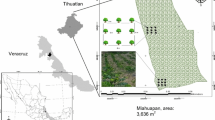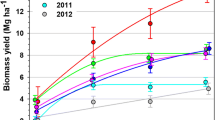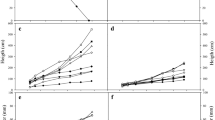Abstract
We tested the effects of phosphorus (P) fertilization and soil water on the growth, physiology, and total nitrogen (N) accumulation in N-fixing Scotch broom in Olympia, WA. We manipulated soil water and P availability via irrigation and fertilization, respectively, in a completely randomized 2 × 2 factorial on potted one-year old Scotch broom seedlings (n = 20) in an N-deficient sand. There was substantial evidence that increased-irrigation and P-fertilization had similar positive effects on N accumulation in Scotch broom approximately equally. High-irrigation rates were more often associated with positive physiological and growth responses in Scotch broom than fertilization, however. Although the irrigation × fertilization interaction was not significant, there were additive effects of high-irrigation and fertilization on biomass and N content as both were 50% greater in the fertilized-and-high-irrigation treatment relative to the respective fertilized and high-irrigation treatments. We noted an accumulation of N and P in the plant tissues. Analyses indicated a pattern of decreasing function and growth with increasing N and P concentrations in Scotch broom biomass, suggesting plant growth and physiology were limited by some other resource. Total plant N content values ranged from 7.0 ± 1.1 g plant−1 in the control and 23.4 g ± 9.0 plant−1 in the fertilized-and-high-irrigation treatment. Extrapolated to typical densities of comparably sized Scotch broom plants on invaded sites in the western Pacific Northwest, these findings suggest that, at least, 12–65 kg N ha−1 would be found in Scotch broom plants in the field.


Similar content being viewed by others
References
Barron, A. R., Wurzberger, N., Bellenger, J.-P., Wright, S. J., Kraepiel, A. M. L., & Hedin, L. O. (2009). Molybdenum limitation of asymbiotic nitrogen fixation in tropical forest soils. Nature Geoscience,2, 42–45.
Barros, L., Dueñas, M., Carvalho, A. M., Ferreira, I. C., & Santos-Buelga, C. (2012). Characterization of phenolic compounds in flowers of wild medicinal plants from Northeastern Portugal. Food and Chemical Toxicology,50, 1576–1582.
Berg, J. M., Tymoczko, J. L., & Stryer, L. (2002). Biochemistry, 5th edn. New York: W H Freeman; Section 24.1, Nitrogen Fixation: Microorganisms Use ATP and a Powerful Reductant to Reduce Atmospheric Nitrogen to Ammonia.
Bergersen, F. J., Gibson, A. H., & Licis, I. (1995). Growth and N2-fixation of soybeans inoculated with strains of Bradyrhizobium japonicum differing in energetic efficiency and PHB utilization. Soil Biology & Biochemistry,27, 611–616.
Bhuvaneswari, T. V., Bhagwat, A. A., & Bauer, W. D. (1981). Transient susceptibility of root cells in four common legumes to nodulation by Rhizobia. Plant Physiology,68(5), 1144–1149.
Bodirsky, L., & Müller, C. (2014). Robust relationship between yields and nitrogen inputs indicates three ways to reduce nitrogen pollution. Environmental Research Letters, 9, 1–4.
Caldwell, B. A. (2006). Effects of invasive Scotch broom on soil properties in a Pacific coastal prairie soil. Applied Soil Ecology,32, 149–152.
Carter, D. R., Slesak, R. A., Harrington, T. B., Peter, D., & D’Amato, A. W. (2018). Scotch broom (Cytisus scoparius) alters microenvironment and promotes nonnative grasses. Biological Invasions, 21, 1055–1073.
Domínguez, J., Gómez-Brandón, M., Martínez-Cordiero, H., & Lores, M. (2018). Bioconversion of Scotch broom into a high-quality organic fertilizer: Vermicomposting as a sustainable option. Waste Management and Research,36(11), 1092–1099.
Eaglesham, A. R. J., & Ayanaba, A. (1984). Tropical stress ecology of Rhizobia, root nodulation and legume fixation. In N.S. Subba Rao (Ed.), Current developments in biological nitrogen fixation (pp. 1–35). New York, NY: Cambridge University Press
Evans, J., Wallace, C., & Dobrowolski, N. (1993). Interaction of soil type and temperature on the survival of Rhizobium leguminosarum BV. Viciae. Soil Biology and Biochemistry,25(9), 1153–1160.
Fellows, R. J., Patterson, R. P., Raper, D., & Harris, D. (1987). Nodule activity and allocation of photosynthate of soybean during recovery from water stress. Plant Physiology,84(2), 456–460.
Fogarty, G., & Facelli, J. M. (1999). Growth and competition of Cytisus scoparius, an invasive shrub, and Australian native shrubs. Plant Ecology,144, 27–35.
Forrest, S. I., Verma, D. P. S., & Dhindsa, R. S. (1991). Starch content and activities of starch- metabolizing enzymes in effective and ineffective root nodules of soybean. Canadian Journal of Botany,69, 697–701.
Grove, S., Parker, I. M., & Haubensak, K. A. (2015). Persistence of a soil legacy following removal of nitrogen fixing invader. Biological Invasions,17, 2621–2631.
Guerin, V., Trinchant, J. C., & Riquad, J. (1990). Nitrogen fixation (C2H2 Reduction) by broad bean (Vicia faba L.) nodules and bacteroids under water-restricted thresholds. Plant Physiology,92(3), 595–601.
Haubensak, K. A., & Parker, I. M. (2004). Soil changes accompanying invasion of the exotic shrub Cytisus scoparius in glacial outwash prairies in Western Washington [USA]. Plant Ecology,175, 71–79.
Hedin, L. O., Brookshire, E. N. J., Menge, D. N. L., & Barron, A. R. (2005). The nitrogen paradox in tropical forest ecosystems. Annual Review of Ecology Evolution and Systematics,40, 613–635.
Helgerson, O. T., Gordon, J. C., & Perry, D. A. (1984). N2 fixation by red alder (Alnus rubra) and Scotch broom (Cytisus scoparius) planted under precommercially thinned Douglas-fir (Pseudotsuga menziesii). Plant and Soil,78, 221–233.
Houlton, B. Z., Wang, Y. P., Vitousek, P. M., & Field, C. B. (2008). A unifying framework for dinitrogen fixation in the terrestrial biosphere. Nature,454, 327–330.
Huitema, B. (2011). Analysis of covariance and alternatives: Statistical methods for experiments, quasi-experiments, and single-case studies (pp. 299–300). Hoboken: Wiley.
Israel, D. W. (1993). Symbiotic dinitrogen fixation and host-plant growth during development of and recovery from phosphorus deficiency. Physiologia Plantarum,88(2), 294–300.
Lenth, R. V. (2016). Least-squares means: The R Package lsmeans. Journal of Statistical Software,69, 1–33.
Malliard, A., Etienne, P., Diquélou, S., Trouverie, J., Billard, V., Yvin, J. C., et al. (2016). Nutrient deficiencies modify the ionomic composition of plant tissues: a focus on cross- talk between molybdenum and other nutrients in Brassica napus. Journal of Experimental Botany,67(19), 5631–5641.
Marino, D., Frendo, P., Ladrera, R., Zabalza, A., Puppo, A., Arrese-Igor, C., et al. (2007). Nitrogen fixation control under drought stress: Localized or systemic? Plant Physiology,143(4), 1968–1974.
Mefford, C., Cohen, S., Sampath, S., Haring, D., Jellicoe, M., Nally, K., et al. (2017). Economic impact of invasives: Direct costs estimates and economic impacts for Washington state. Seattle: Community Attributes Inc.
Pinheiro, J., Bates, D., DebRoy, S., Sarkar, D., & R Development Core Team. (2015). nlme: Linear and nonlinear mixed effects models. R package version 3.1-108
Potter, K. J. B., Kritcos, D. J., Watt, M. S., & Leriche, A. (2009). The current and future potential distribution of Cytisus scoparius: A weed of pastoral systems, natural ecosystems and plantation forestry. Weed Research,49, 271–282.
Prober, S. M., & Lunt, I. E. (2009). Restoration of Themeda australis swards suppresses soil nitrate and enhances ecological resistance to invasion by exotic annuals. Biological Invasions,11, 171–181.
R Core Team. (2017). R: A language and environment for statistical computing. Vienna: R Foundation for Statistical Computing. https://www.R-project.org/. Accessed Jan 5 2017.
Rivaie, A. A. (2011). Growth response of broom (Cytisus scoparius) growing with and without radiata pine (Pinus radiata) seedling to different P levels in soils. Journal of Forestry Research,22, 597.
Rueden, C. T., Schindelin, J., & Hiner, M. C. (2017). Image J2: ImageJ for the next generation of scientific image data. BMC Bioinformatics,18, 529.
Schulze, J. (2004). How are nitrogen fixation rates regulated in legumes? Journal of Plant Nutrition and Soil Science,167, 125–137.
Shaben, J., & Myers, J. H. (2009). Relationships between Scotch broom (Cytisus scoparius), soil nutrients, and plant diversity in the Garry oak savannah ecosystem. Plant Ecology,207, 81–91.
Slesak, R. A., Harrington, T. B., & D’Amato, A. W. (2016). Invasive Scotch broom alters soil chemical properties in Douglas-fir forests of the Pacific Northwest, USA. Plant and Soil,398, 281–289.
Sprent, J. I. (1985). Nitrogen fixation in arid environments. Plants for arid lands. London: George Allen & Unwin.
Thorne, M. S., Skinner, Q. D., Smith, M. A., Rodgers, J. D., Laycock, W. A., & Cerekci, S. A. (2002). Evaluation of a technique for measuring canopy volume of shrubs. Journal of Range Management,55, 235–241.
Tutin, T. G., Heywood, V. H., Burges, N. A., Moore, D. M., Valentine, D. H., Walters, S. M., et al. (1968). Flora Europea (Vol. 2, p. 89). Cambridge: Cambridge University Press.
Vance, C. P., & Heichel, G. H. (1991). Carbon in N2 fixation: limitation or exquisite adaptation. Annual Review of Plant Biology,42(1), 373–390.
Vitousek, P. M., Menge, D. N. L., Reed, S. C., & Cleveland, C. C. (2013). Biological nitrogen fixation: Rates, patterns and ecological controls in terrestrial ecosystems. Philosophical Transactions of the Royal Society B,368, 1–9.
Watt, M. S., Clinton, P. W., Whitehead, D., Richardson, B., Mason, E. G., & Leckie, A. C. (2003a). Above-ground biomass accumulation and nitrogen fixation of broom (Cytisus scoparius L.) growing with juvenile Pinus radiata on a dryland site. Forest Ecology and Management,184, 93–104.
Watt, M. S., Whitehead, D., Mason, E. G., Richardson, B., & Kimberly, M. O. (2003b). The influence of weed competition for light and water on growth and dry matter partitioning of young Pinus radiata, at a dryland site. Forest Ecology and Management,183, 363–376.
Wheeler, C. T., Helgerson, O. T., Perry, D. A., & Gordon, J. C. (1987). Nitrogen fixation and biomass accumulation in plant communities dominated by Cytisus scoparius L. in Oregon and Scotland. Journal of Applied Ecology,24(1), 231–237.
Williams, P. A. (1981). Aspects of the ecology of broom (Cytisus scoparius) in Canterbury, New Zealand. New Zealand Journal of Botany,19, 31–43.
Acknowledgements
We would like to thank James Dollins, Alyssa Peter, LeRoy Turner and Dave Peter for their help setting up and maintaining this study, as well as taking field measurements. Funding for this project was provided by the USDA National Institute for Food and Agriculture (Grants.Gov Number: GRANT11325729).
Author information
Authors and Affiliations
Corresponding author
Additional information
Publisher's Note
Springer Nature remains neutral with regard to jurisdictional claims in published maps and institutional affiliations.
Rights and permissions
About this article
Cite this article
Carter, D.R., Slesak, R.A., Harrington, T.B. et al. Effects of irrigation and phosphorus fertilization on physiology, growth, and nitrogen-accumulation of Scotch broom (Cytisus scoparius). Plant Physiol. Rep. 24, 410–421 (2019). https://doi.org/10.1007/s40502-019-00459-7
Received:
Accepted:
Published:
Issue Date:
DOI: https://doi.org/10.1007/s40502-019-00459-7




